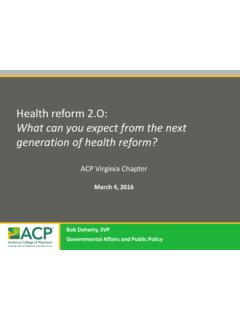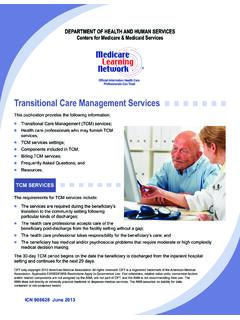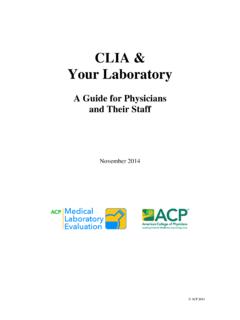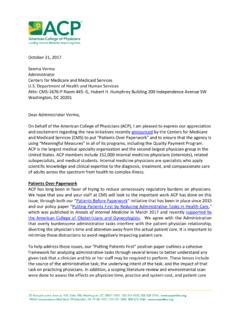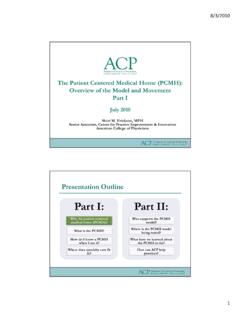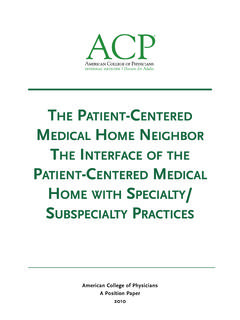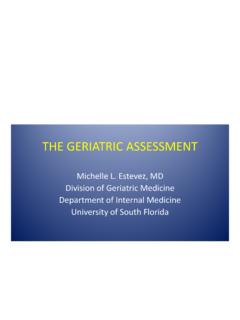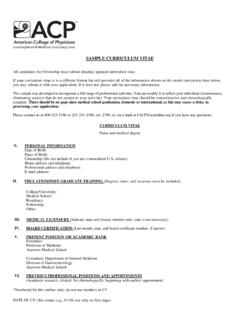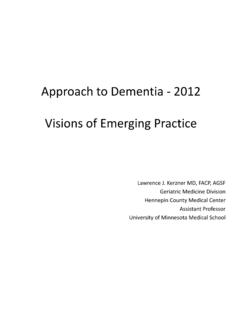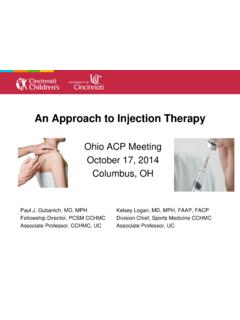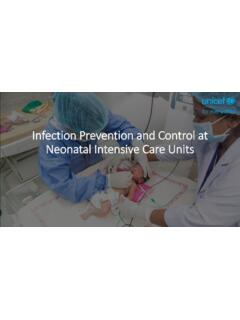Transcription of in the clinic Acute Sinusitis - Internal Medicine | ACP
1 In the clinic in the clinic Acute Sinusitis Risk Factors page ITC3-3. Diagnosis page ITC3-4. Treatment page ITC3-8. Practice Improvement page ITC3-13. CME Questions page ITC3-16. Section Editors The content of In the clinic is drawn from the clinical information and Barbara J. Turner MD, MSED education resources of the American College of Physicians (ACP), including Sankey Williams, MD PIER (Physicians' Information and Education Resource) and MKSAP (Medical Darren Taichman, MD, PhD Knowledge and Self-Assessment Program). Annals of Internal Medicine editors develop In the clinic from these primary sources in collaboration with Science Writer the ACP's Medical Education and Publishing Division and with the Jennifer F. Wilson assistance of science writers and physician writers. Editorial consultants from PIER and MKSAP provide expert review of the content.
2 Readers who are interested in these primary resources for more detail can consult , mksap/15/?pr31, and other resources referenced in each issue of In the clinic . CME Objective: To review current evidence for the risk factors, diagnosis, and treatment of Acute Sinusitis . The information contained herein should never be used as a substitute for clini- cal judgment. 2010 American College of Physicians This article has been corrected. The specific correction appears on the last page of this document. For original version, click "Original Full Text (PDF)" in column 2 of the article at cute Sinusitis affects millions of persons in the United States every A year and is among the most common reasons for physician visits, prompting over 3 million visits annually (1). The more accurate term for this condition is Acute rhinosinusitis, because symptoms involve both the nasal cavity and the sinuses.
3 For simplicity, this review uses the term sinusi- tis for rhinosinusitis. There are 4 pairs of air-filled paranasal sinuses: the frontal, maxillary, ethmoid, and sphenoid sinuses. Acute Sinusitis typically oc- curs in the maxillary sinuses (Figure). Sinusitis is characterized as Acute when the duration of symptoms is shorter than 4 weeks, subacute when the dura- tion is from 4 weeks to 12 weeks, and chronic when the duration is more than 12 weeks. Sinusitis seems to be due to congestion and blockage of the nasal passages, usually in response to viral infection or allergic rhinitis but oc- casionally to other stimuli. The paranasal sinuses become inflamed, and mu- cus cannot drain properly, providing an environment where bacteria, or rarely fungus, can thrive. Persons with chronic nasal congestion, and particularly those with allergies and asthma, may be more prone to developing Acute si- nusitis, but it can affect anyone.
4 Suggestive symptoms include headache, con- gestion, facial pain, fatigue, and cough, all of which can be disruptive to usual activities but are rarely severe. The diagnosis is usually based on clinical signs and symptoms. Radiologic tests are not recommended initially and, to make the diagnosis from culture, primary care physicians do not typically perform anterior rhinoscopy or antral puncture with aspiration. Evidence is lacking regarding optimum pre- vention and treatment. It is well known that physicians grossly overprescribe antibiotics for presumed Acute bacterial Sinusitis despite a high prevalence of viral infection causing symptoms. Moreover, 4 of 5 persons recover within 2. weeks without treatment (2). Overprescription of antibiotics probably reflects difficulty in establishing the diagnosis of Sinusitis and in distinguishing viral from bacterial Acute Sinusitis .
5 The risk for bacterial Sinusitis is low until the symptoms persist for at least 7 to 10 days. A Cochrane review of 57 random- ized, controlled trials (RCTs) from 1950 to 2007 of antibiotics in the treat- ment of Acute bacterial Sinusitis reported that antibiotic treatment reduced the risk for clinical failure at 7 to 15 days but was associated with significant side effects (2). When treatment is ineffective and Sinusitis persists, or when symptoms are severe, sinus puncture, imaging, and other diagnostic tests may be helpful in guiding management. In these cases, evaluation by a specialist may be warranted. 1. Anand VK. Epidemiol- ogy and economic impact of rhinosinusi- tis. Ann Otol Rhinol Laryngol Suppl. 2004;193:3-5. [PMID: 15174752]. 2. Ahovuo-Saloranta A, Borisenko OV, Kova- nen N, et al. Antibi- otics for Acute maxil- lary Sinusitis .
6 Cochrane Database Syst Rev. 2008:CD000243. [PMID: 18425861]. 3. Mahakit P, Pumhirun P. A preliminary study of nasal mucociliary clearance in smokers, Sinusitis and allergic rhinitis patients. Asian Pac J Allergy Im- Figure. Diffuse pansinusitis with mucosal thickening and polyposis in the munol. 1995;13:119- 21. [PMID: 8703239] anterior sinuses. 2010 American College of Physicians ITC3-2 In the clinic Annals of Internal Medicine 7 September 2010. Risk Factors What factors increase the risk for maxillary rhinosinusitis (4). How- Acute Sinusitis ? ever, persons with asthma are more Most persons with Acute Sinusitis prone to chronic Sinusitis , as are have had a recent upper respiratory persons with a condition known as viral infection, but Acute Sinusitis can Samter Triad or the ASA Triad, also occur with allergies or exposure which is characterized by asthma, to local irritants.
7 These last 2 causes nasal polyps, and aspirin intolerance. are generally characterized by more In addition, persons with a deviated recurrent or chronic symptoms. Im- nasal septum may also have an in- munocompromised persons are at creased risk for both Acute and increased risk for fungal infection. chronic Sinusitis . Age Dental disease Older persons have more compro- Infections from dental disease, mised immune systems and a such as dental abscesses and peri- greater prevalence of serious upper odontal infection, or procedures, respiratory tract infections, both of such as sinus perforations during which increase their risk for the tooth extraction, can precipitate complication of Acute Sinusitis . Sinusitis . Patients with dental pain They also tend to have weakened may indeed have Sinusitis , espe- cartilage and dryness in the nasal cially involving the upper teeth passages that can promote infec- and commonly the wisdom teeth.
8 Tion. Because young children have According to one review, odonto- more colds and smaller nasal and genic Sinusitis accounts for about sinus passages, they face an in- 10% to 12% of maxillary Sinusitis creased risk for Sinusitis as well. cases (5). In such cases, the un- derlying dental condition may be Smoke and other air pollutants asymptomatic or only mildly Cigarette and cigar smoke and other symptomatic. Intervention is forms of air pollution, such as indus- needed to stop the disease pro- trial chemicals, increase the risk for gression and to avoid excess an- Sinusitis . Air pollution can damage tibiotic treatment. the cilia responsible for moving mu- cus out of the sinuses (3). Other medical conditions Medical conditions that cause in- Air travel and changes in atmospheric pressure flammation in the airways or create Air travel as well as other situations persistent thickened stagnant mucus that involve changes in atmospheric can increase the risk for recurrent pressure, such as deep sea diving or Acute or chronic Sinusitis , such as di- climbing to high altitude, increase the abetes and other disorders of the im- risk for sinus blockage and Sinusitis .
9 Mune system. AIDS and poorly con- trolled diabetes particularly increase 4. Small CB, Bachert C, Lund VJ, et al. Judi- Swimming the risk for Acute invasive fungal si- cious antibiotic use In frequent swimmers, the chlorine nusitis, which is called mucormyco- and intranasal corti- costeroids in Acute in pools can irritate the lining of sis, zygomycosis, or fulminant inva- rhinosinusitis. Am J. the nose and sinuses and can lead sive Sinusitis (6). Pregnancy can also Med. 2007;120:289- 94. [PMID: 17398218]. to Sinusitis . cause temporary congestion and 5. Brook I. Sinusitis of odontogenic origin. symptoms of Sinusitis . Otolaryngol Head Asthma and allergies Neck Surg. Asthma and respiratory allergies An autoimmune disease, Wegener 2006;135:349-55. [PMID: 16949963]. increase sinus inflammation, which granulomatosis, causes long-term 6.
10 Deshazo RD. Syn- dromes of invasive can increase the risk for infection. swelling and tumor-like masses in fungal Sinusitis . Med Allergic rhinitis may contribute air passages and predisposes to Mycol. 2009;47 Suppl 1:S309-14. to up to 30% of cases of Acute Acute as well as chronic Sinusitis . [PMID: 18654920]. 7 September 2010 Annals of Internal Medicine In the clinic ITC3-3 2010 American College of Physicians Persons with abnormalities in cil- and remove pathogens from the si- In most cases, Acute iary function or mucous produc- nuses (Box). Using saline irrigation tion, such as cystic fibrosis or the and steam inhalation can help keep Sinusitis is diagnosed Kartagener syndrome (triad of the nose moist and the sinuses based on the history and bronchiectasis, Sinusitis , and dex- clear. A humidifier can moisten air trocardia), are also more likely to in dry indoor environments.
